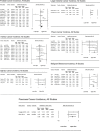Meta-Analysis of Incidence and Mortality of Firefighter Cancer: An Update on Emerging Science
- PMID: 38546063
- PMCID: PMC11152373
- DOI: 10.31557/APJCP.2024.25.3.801
Meta-Analysis of Incidence and Mortality of Firefighter Cancer: An Update on Emerging Science
Abstract
Background: Firefighters are faced with a broad range of toxic exposures during their work, including known and suspected carcinogens. The current study is an update to the previously published meta-analysis of cancer risk among firefighters by Soteriades and colleagues, and focuses on studies published from 2008 to 2020.
Methods: A comprehensive search of the literature was conducted, including electronic databases and bibliographies of recently published papers. Analyses include stratification of studies conducted in the United States (US) versus other countries. Cancer incidence and mortality rates were compared to the relevant general population. Random effects models were used to calculate summary risk estimates and their 95% confidence intervals.
Results: A total of 24 studies were included in the meta-analysis. Among the 42 cancer types covered, incidence was associated with firefighting in US samples for colon, kidney, large intestine, pleura, and prostate cancer, as well as malignant melanoma. There was an increased incidence of Hodgkin's Disease and malignant melanoma and a significantly lower risk of kidney cancer for non-US samples. Significant cancer mortality estimates for US samples included oral/buccal/mouth, other parts of the buccal cavity, pharynx, colon, esophagus, large intestine, lung, Non-Hodgkin's Lymphoma, pancreas, pleura, rectum, and soft tissue sarcoma. No cancer had a significantly higher rate of mortality among non-US samples.
Conclusions: The findings underscore the global cancer burden among firefighters, and indicate that geographically stratifying studies afford a more nuanced risk perspective. Further research should investigate why US firefighters exhibit higher cancer mortality rates compared to international counterparts.
Keywords: Firefighter; Meta-analysis; cancer; occupational health; public safety.
Figures




References
-
- Jahnke SA, Jitnarin N, Kaipust CK, Hollerbach BH, Naylor BM, Crisp C. Fireground exposure of firefighters: A literature review. Quincy, MA: Fire Protection Research Foundation; 2021.
-
- Demers PA, DeMarini DM, Fent KW, Glass DC, Hansen J, Adetona O, et al. Carcinogenicity of occupational exposure as a firefighter. Lancet Oncol. 2022;23(8):985–6. - PubMed
-
- Saland G, Seley GP. Lung cancer in new york city firemen. N Y State J Med. 1963:63:92–4. - PubMed
-
- International Agency for Research on C. Painting, firefighting, & shiftwork . 2010.
Publication types
MeSH terms
LinkOut - more resources
Full Text Sources
Medical

